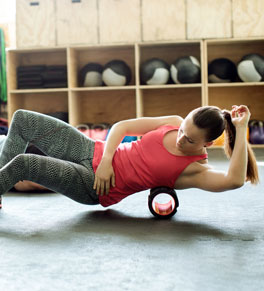No pain, no gain — a myth?

No pain, no gain.
Patients often ask if that adage is true when it comes to exercising and athletic activity.
In general, you do need to push yourself to some level of discomfort to make gains in strength or cardiovascular fitness, says UCI Health family medicine physician Dr. Christopher Kroner, who specializes in sports medicine.
People who are sedentary are familiar with stiffness or soreness that may linger for a day or two after exercising. These are normal responses to using muscles that are unaccustomed to a particular activity.
Push past point of discomfort
People who do exercise regularly know well that feeling of burning or fatigue in their muscles when they push a little harder than they are comfortable with.
"Here’s what’s happening in your body," he explains. "When you push a muscle to work beyond its ability to use oxygen delivered in the blood, you’re creating lactic acid, which gives you that burning sensation. It’s what exercise-experienced people usually recognize as a really good fatigue, or a good workout."
The production of lactic acid actually plays a role in creating more blood flow to the muscles so that you gain more strength and endurance next time.
So, yes, no pain, no gain is true for activities such as running, swimming or lifting weights.
The heart is a different story
Cardiovascular gains are a little different. The heart can get stronger and more efficient at less than maximum fatigue.
If your heart is beating temporarily at a faster heart rate — say in moderate walking or slow jogging — you will not feel pain. Your heart muscle still benefits a great deal.
If you’re middle aged, however, and you begin to feel pain in your chest while exercising, we want you to slow down. Cardiovascular disease is the leading cause of death among Americans age 35 and older.
If you’re younger than that and you feel chest pain, it’s very unlikely to be a heart problem. Still, it’s a good idea to be cautious, and if you’re at all concerned, talk to your doctor.
When you should stop
Although I’m saying you should feel some burning or fatigue to make gains in strength and endurance, certain types of pain may be a warning signal to stop.
They include:
- A severe or sharp pain during a workout. This indicates that something is stressed, inflamed, damaged or sensitive. Do not push through it.
- A pain that feels as if tissue is being pulled apart when stretching. Stretch only to the point where you feel a slight pain, hold it, push a bit more and release.
Avoid injury with proper technique
Proper technique is vital to avoiding injuries during workouts. I recommend working with a trainer who understands your goals.
Overdoing it with incorrect form can lead to tendonitis, bursitis or stress fractures. Listen to your body. If you’re experiencing pain that you’re not used to, change your technique and see if goes away.
One of my patients experienced pain when doing bicep curls. I didn’t see anything wrong, but when I suggested a grip change, the pain went away. Sometimes it can be a really small change that makes the difference.
Even experienced athletes can lessen their chances of injury by paying attention to their form and technique. For example, if you get lazy you could easily drop a weight on yourself or not place it back in the holder correctly. More often, as we get fatigued during a workout, our form suffers and stress injuries can occur.
Use it or lose it
Here’s where the no-gain part comes in.
When you’re not feeling any pain, your improvements have likely plateaued. You’re still benefiting by maintaining your conditioning. But if you want to do better and get stronger, you have to push harder.
If you stay away from training, the muscles used for those particular activities will start shrinking or getting tighter. Don’t go more than two days without some type of workout or physical activity.
Some muscles lose strength faster than others. For example, a person immobilized for a week after surgery will need physical therapy to get their quadriceps back in shape. Other muscles, such as those in the arms, won’t shrink as quickly.
Curiously, there is some evidence that when you work muscles in one part of the body, it also helps muscles elsewhere in your body. So you should definitely keep moving to stay healthy.




